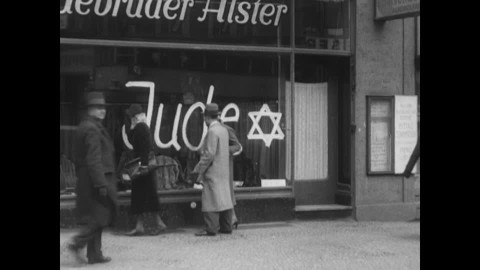 When it comes to antisemitism, having reported and taught about it for over two decades, I have found that it has been too often under-reported, minimized, or even ignored. It usually takes great effort to speak up and expose the lies and the venom of Jew-hatred, but it must be done. So, when it looks like justice was served, I am always ready to recognize it for what it is worth. Let me back it up to the end of 2023, a few weeks after the Hamas terrorist attack in southern Israel that started the current war.
When it comes to antisemitism, having reported and taught about it for over two decades, I have found that it has been too often under-reported, minimized, or even ignored. It usually takes great effort to speak up and expose the lies and the venom of Jew-hatred, but it must be done. So, when it looks like justice was served, I am always ready to recognize it for what it is worth. Let me back it up to the end of 2023, a few weeks after the Hamas terrorist attack in southern Israel that started the current war.
It didn’t take long for the world to stop talking about the 1,200 Israelis brutally maimed, burned, raped and murdered, not to mention the over 200 hostages. Within a week, much of the planet was focusing on what they have since called a “humanitarian crisis in Gaza.” Don’t get me wrong; the Palestinians stuck in Gaza are in dire need of essentials such as food, water, medical help, and shelter (not to mention Yeshua’s salvation). This being said they are not stuck because Israel is keeping them there but because Hamas is. These facts do not matter to our younger generation chanting from US campus to US campus, “From the River to the Sea, Palestine shall be free,” fulfilling their need for social justice and their desire for multiculturalism, at least in their own heads. This chanting is being done mostly by people unaware of the real genocidal meaning of the statement, but also by some who are clearly aware of this being a call for the total eradication of all Jews of Israel. This has nothing to do with social justice.
University campuses have long become a breeding ground for radicalism, which always includes antisemitism at the top of the list. From New York to California and from MIT to Harvard, students have been very vocal and, at times, physical with their disdain for Israel and the Jewish people. This is nothing new, but October 7, 2023, revitalized the oldest hatred and emboldened its most timid proponents. So, when Harvard, Penn and MIT made the news, I was not surprised. What surprised me was the concerted answer given by the presidents of the schools when asked to testify before the House Education and Workforce Committee on Dec. 5 in Washington, D.C. Their answers, at the very least, lacked moral clarity. When asked by Congresswoman Elise Stefanik whether “calling for the genocide of Jews was violating the code of conduct and rules” of their respective schools, the three presidents offered each their own version of a lukewarm response, vaguely denouncing racism and, again, lacking moral clarity at a time when firm responses were needed.
Harvard President Claudine Gay responded, “It depends on the context.” Forget for a moment that we are speaking of the genocide of Jewish people, and let us ponder: in what context is genocide ever acceptable? What race or ethnic group would ever deserve genocide at any point in history? The obvious answer is none! Yet, according to Miss Gay, when it comes to the genocide of the Jewish people, context is key. Once she had given that answer, unless she made an immediate 180, she had reached the point of no return. She should have been fired immediately, but the Harvard Board backed her up.
Then, another accusation against Claudine Gay surfaced. She was accused of having committed plagiarism multiple times while working on her Ph.D. The accusations turned out to be true and, under heavy criticism, she was forced to resign. This was absolutely the right thing to do, but I still wonder if it was the right context. Let me explain.
The minute she let out that a genocide of the Jewish people depended on the context was the minute she should have resigned or been fired, period. That she didn’t see the gravity of her statement was bad enough as a human being, but much worse as the president of an Ivy League school such as Harvard. Then, the board backed her up and kept her in her position. Both Miss Gay and the Harvard board dug their heels. They wouldn’t address the elephant in the room: antisemitism. What happened next could be called the “Al Capone Method”. In Capone’s case, not able to get him for multiple murders, the authorities arrested him, found him guilty, and incarcerated him, but for tax evasion. To be sure, I am not comparing Miss Gay to Al Capone but simply making a parallel in the methodology used. Different means to the same end. When she should have been fired for antisemitism, Miss Gay wasn’t, but soon after, she was accused of multiple cases of plagiarism connected to her Ph.D., and for that, she eventually had to resign from her position as President of Harvard. She did issue an apology for her faux pas…too little too late, and the firing was deserved but based on the wrong motive. Incidentally, Miss Gay has retained her teaching position at Harvard.
When it comes to Jew-hatred, it is always easier to condemn historical antisemitism, such as the crimes of the Nazis or even other crimes against the Jews throughout history. What is done is done and it is far enough removed in the past for anyone to argue its veracity unless they are historical revisionists. The challenge with modern antisemitism is that it is happening in front of our very eyes, and so we have a duty to expose it and denounce it. We must take sides in real-time, and this might affect us in many ways. The price might be high, but it is the price to pay for doing the right thing.
I will not pretend to know where Miss Gay or the Harvard Board members stand in their personal relationship with God, but for me, as I have been a follower of Yeshua of Nazareth for 40 years, and I understand the place of Israel and the Jewish people in God’s master plan for humanity. I have no other alternative but to be grateful to the God who saved me and to love Israel and the Jewish people as much as I can, which will never come close to how much God loves them (Zechariah 2:8.)
We will continue to see an increase in Jew-hatred for the foreseeable future; the question remains: does the Jewish community or the Jewish people in your sphere of influence know that you have their backs? There couldn’t be a better time to be vocal about our support of Israel and the Jewish people.



